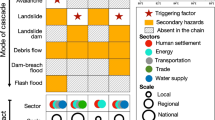Abstract
Natural hazards are natural processes of the complex Earth system and may interact and affect each other. Often a single hazard can trigger a subsequent, different hazard, such as earthquakes triggering landslides. The effect of such cascading hazards has received relatively little attention in the literature. The majority of previous research has focused on single hazards in isolation, and even multi-hazard risk assessment currently does not account for the interaction between hazards, therefore ignoring potential amplification effects. Global earthquake-and-landslide fatality data were used to model cascading events to explore relationships between the number of fatalities during single and cascading events and covariates. A multivariate statistical approach was used to model the relationship between earthquake fatalities and several covariates. The covariates included earthquake magnitude, gross domestic product, slope, poverty, health, access to cities, exposed population to earthquake shaking, building strength and whether a landslide was triggered or not. Multivariate regression analysis showed the numbers of earthquake fatalities are significantly affected by whether a subsequent landslide is triggered or not.







Similar content being viewed by others
References
Allen TI, Marano KD, Earle PS, Wald DJ (2009) PAGER-CAT: A composite earthquake catalog for calibrating global fatality models. Seism Res Lett 80(1):57–62
Buzna L, Peters K, Helbing D (2006) Modelling the dynamics of disaster spreading in network. Physica A 363(1):132–140
Buzna L, Peters K, Ammoser H, and Helbing D (2007) Efficient response to cascading disaster spreading. Phys Rev E 75:1-7
Carpignano A, Golia E, Di Mauro C, Bouchon S, Nordvik J-P (2009) A methodological approach for the definition of multi-risk maps at regional level: first application. J Risk Res 12(3):513–534
CIESIN (2005) Gridded Population of the World, Version 3 (GPWv3), Palisades, NY, CIESIN, Columbia University. http//sedac.ciesin.columbia.edu/gpw/index.jsp. Accessed 1st Feb 2012
Dilley M, Chen S, Lerner-Lam A (2005) Natural Disaster Hotspots: A Global Risk Analysis. The World Bank and Columbia University
El-Masri S, Tipple G (1997) Urbanization, poverty and natural disasters: vulnerability of settlements in developing countries. Reconstr After Disasters 12(2):141–158
Fleming G (2002) Learning to live with rivers: the ICE’s report to government. Civ Eng 150:15–21
Greiving S (2006) Integrated risk assessment of multi-hazards: a new methodology. In: P Schmidt-Thome (ed) Natural and Technological Hazards and Risks Affecting the Spatial Development of European Regions, Geological Survey of Finland, Special Paper 42, 75–82
Helbing D, Kuhnert C (2003) Assessing interaction networks with applications to catastrophe dynamics and disaster management. Physica A 328(3–4):584–606
Helbing D, Ammoser H, Kühnert C (2005) Disasters as extreme events and the importance of network interactions for disaster response management. In: Albeverio S, Jentsch V, Kantz H (eds) The unimaginable and unpredictable: extreme events in nature and society. Springer, Berlin, pp 319–348
Hengl T and Reuter HI (2010) Worldgrids—a public repository and a WPS for global environmental layers: Slope Map. http://worldgrids.org/doku.php?id=wiki:slpsrt3. Accessed 9th Feb 2012
Jaiswal K and Wald DJ (2008) Creating a Global Building Inventory for Earthquake Loss Assessment and Risk Management: Open-File Report 2008-1160: Appendix VII: PAGER_database_v1.4.xls. http//pubs.usgs.gov/of/2008/1160/downloads/PAGER_database/. Accessed 4th Mar 2012
Jaiswal KS, Wald D (2010) An empirical model for global earthquake fatality estimation. Earthq Spectra 26(4):1017–1037
Kappes M, Keiler M, and Glade T (2010) From Single- to Multi-Hazard Risk Analyses: a concept addressing emerging challenges. In Mountain Risks: Bringing Science to Society, eds J-P Malet, T Glade and N Casagli, Proceedings of the ‘Mountain Risks’ International Conference, Nov 2010
Kappes M, Keiler M, von Elverfeldt K, Glade T (2012) Challenges of analyzing multi-hazard risk: a review. Nat Hazards 64(2):1925–1958
Kates RW, and Haarmann (1992) Where the poor live: are the assumptions correct? Environment 34, 4, 4–11, 25–28
Keefer DK (1984) Geological society of America bulletin landslides caused by earthquakes. Geol Soc Am Bull 95(4):406–421
Keefer DK (2002) Investigating landslides caused by earthquakes: a historical review. Surv Geophys 23:473–510
Korup O (2010) Earthquake-triggered landslides: spatial patterns and impacts. COGEAR, Module 1a Report
Lerner-Lam A (2007) Assessing global exposure to natural hazards: progress and future trends. Environ Hazards 7:10–19
Macintyre AG, Barbera JA, Smith ER (2006) Surviving collapsed structure entrapment after earthquakes: a “time-to rescue” analysis. Prehosp Disaster Med 21(1):4–19
Marano KD, Wald DJ, Allen TI (2010) Global earthquake casualties due to secondary effects: a quantitative analysis for improving rapid loss analyses. Nat Hazards 52:319–328
Marzocchi W, Mastellone ML, and Di Ruocco A (2009) Principles of multi-risk assessment: Interaction amongst natural and man-induced risks. European Commission EU 23615
Meunier P, Houvis N, Haines JA (2007) Regional patterns of earthquake-triggered landslides and their relation to ground motion. Geophys Res Lett 34:L20408
Nelson A (2008) Travel time to major cities: A global map of Accessibility. Global environment monitoring unit: Joint Research Centre of the European Commission, Ispra Italy. http://www-tem.jrc.it/accessibility. Accessed 9 Mar 2012
Peduzzi P, Dao H, Herold C, Mouton F (2009) Assessing global exposure and vulnerability towards natural hazards: the disaster risk index. Earth 4:1149–1159
Rodriguez CE, Bommer JJ, Chandler RJ (1999) Earthquake-induced landslides: 1980–1997. Soil Dyn Earthq Eng 18:325–346
Shi P (2005) Theory and practice on disaster system research. Paper for the Fifth Annual IIASA-DPRI Forum
Sidle RC, Ochiai H (2006) Landslides: processes, prediction, and landuse. Water Resour Monogr. AGU, Washington, DC
UNDP (2004) Reducing disaster risk: a challenge for development. UNDP Bureau for Crisis Prevention and Recovery, New York 146 pp
UNDP (2013) International Human Development Indices: Data. http://hdrstats.undp.org/en/tables/. Accessed 1 Mar 2012
UNU-EHS (2011) World Risk Report 2011
Yetman G, Gaffin SR, and Xing X (2004) Global 15 × 15 Minute Grids of the Downscaled GDP Based on the SRES B2 Scenario, 1990 and 2025. Palisades, NY: NASA Socioeconomic Data and Applications Center (SEDAC). http://sedac.ciesin.columbia.edu/data/set/sdp-downscaled-gdp-grid-b2-1990-2025. Accessed 1 Mar 2012
Acknowledgments
We would like to thank the Centre for Research on the Epidemiology of Disasters and US Geological Survey for the provision of earthquake data.
Author information
Authors and Affiliations
Corresponding author
Appendix 1
Rights and permissions
About this article
Cite this article
Budimir, M.E.A., Atkinson, P.M. & Lewis, H.G. Earthquake-and-landslide events are associated with more fatalities than earthquakes alone. Nat Hazards 72, 895–914 (2014). https://doi.org/10.1007/s11069-014-1044-4
Received:
Accepted:
Published:
Issue Date:
DOI: https://doi.org/10.1007/s11069-014-1044-4




